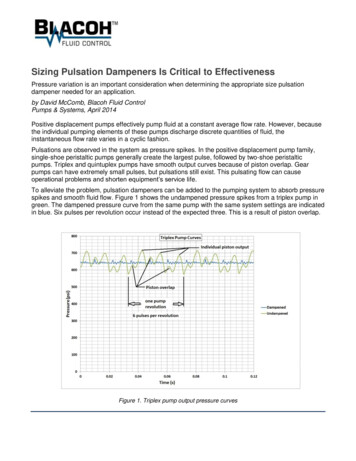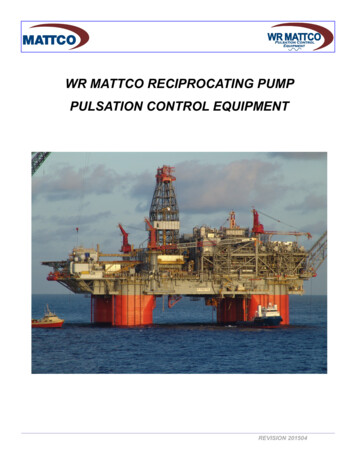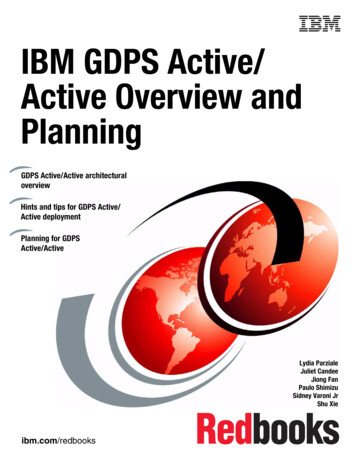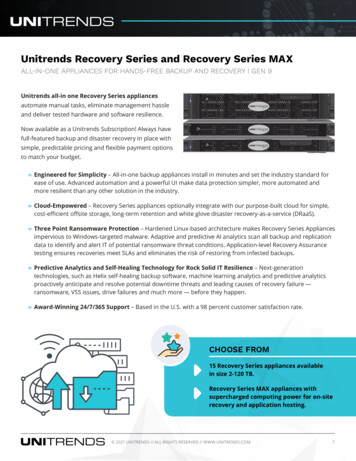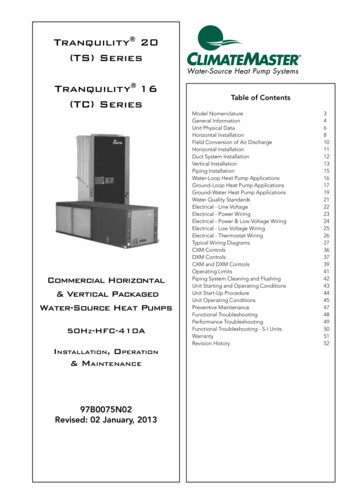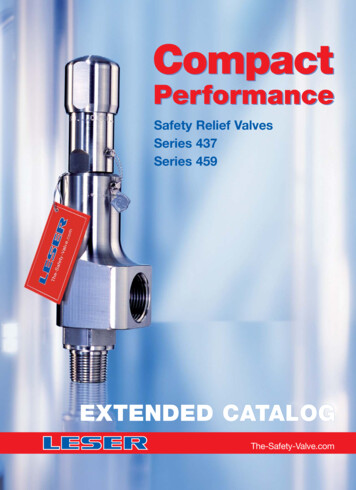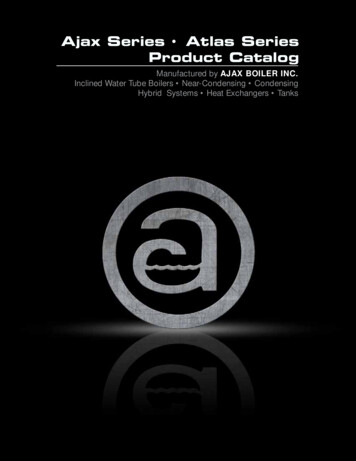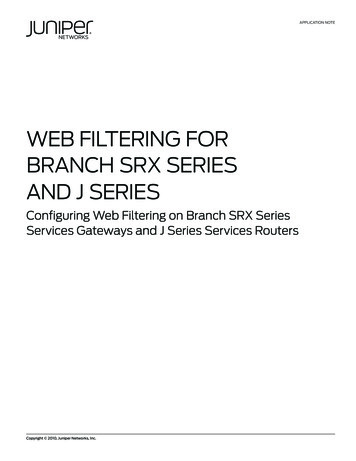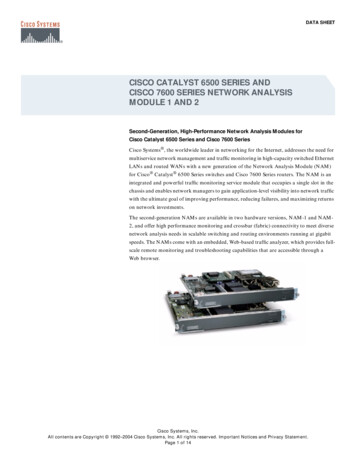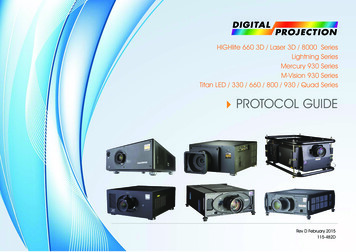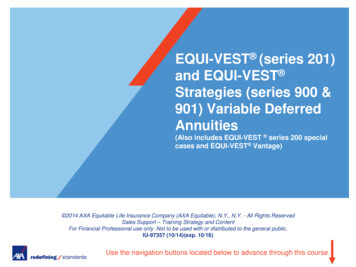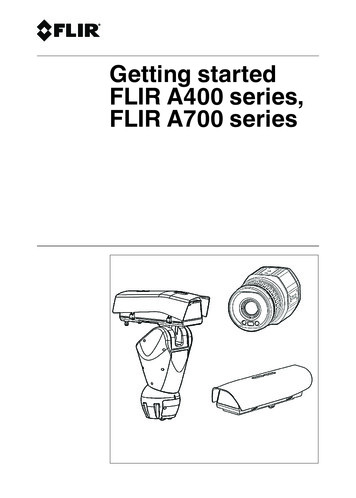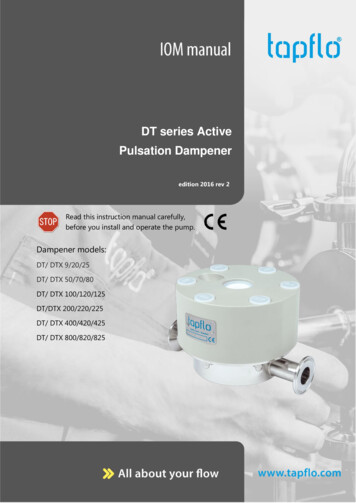
Transcription
DT series ActivePulsation Dampeneredition 2016 rev 2Read this instruction manual carefully,before you install and operate the pump.Dampener models:DT/ DTX 9/20/25DT/ DTX 50/70/80DT/ DTX 100/120/125DT/DTX 200/220/225DT/ DTX 400/420/425DT/ DTX 800/820/825
CONTENTS0.GENERAL . 50.1.Introduction. 50.2.Warning symbols . 50.3.Qualification and training of personnel . 51.INSTALLATION . 61.1.Operation principle . 61.2.Receiving inspection . 61.3.Storage . 71.4.Health and safety . 71.4.1.Protection . 71.4.2.Explosion hazardous environments – ATEX . 71.4.3.Air pressure . 81.4.4.Noise level . 81.4.5.Temperature hazards . 81.5.Air connection . 81.6.Example of installation . 92.OPERATION . 102.1.3.Before starting the dampener. 10MAINTENANCE . 113.1.When the dampener is new or reassembled. 113.2.Routine inspection . 113.3.Complete inspection . 113.4.Location of faults . 113.5.Disassembly of the dampener. 123.5.1.Before the disassembly procedure . 123.5.2.Disassembly procedure . 123.6.Assembly of the dampener . 143.6.1.4.Test run . 16SPARE PARTS . 174.1.Spare parts drawing - PE & PTFE, Aluminium . 174.2.Spare parts drawing – steel and sanitary . 184.3.Spare parts list – steel and sanitary . 184.4.Stocking recommendation . 194.5.How to order parts. 194.6.Dampener code . 19IOM manual active pulsation dampeners2
CONTENTS5.TECHNICAL DATA . 205.1.Overall dimensions . 205.2.Tightening torques . 216.WARRANTY . 226.1.Warranty form . 226.2.Returning parts . 236.3.Warranty . 23IOM manual active pulsation dampeners3
CE CERTIFICATEEC declaration of conformityMachinery directive 2006/42/ECPressure equipment directive 97/23/EC, Category ITapflo AB declares that:Product name:Active Pulsation DampenerModels:DT is in conformity with the essential health and safety requirements and technicalconstruction file requirements of the EC Machinery directive 2006/42/EC,and is in conformity with the Pressure Equipment Directive (PED) 97/23/ECCategory I.Manufactured by Tapflo Sp. z o. o., Poland for:Tapflo ABFilaregatan 4S-442 34 KungälvSwedenTapflo AB, January 1st 2014Håkan EkstrandManaging directorIOM manual active pulsation dampeners4
0.GENERAL0.GENERAL0.1.IntroductionThe active pulsation dampener is the most efficient way to remove pressure variations on thedischarge of the pump. The Tapflo pulsation dampener works actively with compressed air anda diaphragm, automatically setting the correct pressure to minimize the pulsations. Thepulsation dampener is available for all Tapflo pump sizes and material versions.With proper attention to maintenance, Tapflo active pulsation dampeners will give efficient andtrouble free operation. This instruction manual will familiarize operators with detailedinformation about installing, operating and maintaining the dampener.0.2.Warning symbolsThe following warning symbols are present in this instruction manual. This is what they say:This symbol stands next to all safety instructions in this instruction manual wheredanger to life and limb may occur. Observe these instructions and proceed withutmost caution in these situations. Inform also other users of all safety instructions.In addition to the instructions in this instruction manual, the general safety andaccident prevention regulations must be observed.This signal stands at points in this instruction manual of particular importance forcompliance with regulations and directives, for correct work flow and for theprevention of damage to and destruction of the complete dampener or itssubassemblies.0.3.Qualification and training of personnelThe personnel in charge of installation, operation and maintenance of the dampener we producemust be qualified to carry out the operations described in this manual. Tapflo shall not be heldresponsible for the training level of personnel and for the fact that they are not fully aware ofthe contents of this manual.IOM manual active pulsation dampeners5
1.INSTALLATION1.INSTALLATION1.1.Operation principleThe pulsation dampener’s main function is to remove pressure variations on the discharge ofthe pump. The dampener works actively with compressed air and a diaphragm, automaticallysetting the correct pressure to minimise the pulsations.The air pressure supplied to the dampener is the same as the one supplied to the pump. Themedium flowing through the dampener affects the diaphragm, which by means of thecompressed air on the air side compensates the fluctuations of pressure in the discharge line.The air concentrated in the dampeners block works as a spring for the medium flowing throughthe dampener.1.2.Receiving inspectionAlthough precaution is taken by us when packing and shipping, we urge you to carefully checkthe shipment on receipt. Make sure that all parts and accessories listed on the packing list areaccounted for. Immediately report any damage or shortage to the transport company and tous.IOM manual active pulsation dampeners6
1.1.3.INSTALLATIONStorageIf the equipment is to be stored prior to installation, place it in a clean location. The dampenershould be stored in an ambient temperature of 15 C (59 F) to 25 C (77 F) and relative humiditybelow 65%. It should not be exposed to any heat source e.g. radiator, sun as this could result ina negative way on the tightness of the dampener. Do not remove protective covers from thesuction, discharge and air connections which have been fastened to keep pump internals freeof debris. Clean the dampener thoroughly before installation.1.4.Health and safetyThe pulsation dampener must be installed according to local and national safety rules.The dampeners are constructed for particular applications. Do not use the dampeners onapplications different from that for which it was sold without consulting us to ascertainits suitability.1.4.1.ProtectionIn the interest of health and safety it is essential to wear protective clothing and safety goggleswhen operating, and/or working in the vicinity of Tapflo dampeners.1.4.2.Explosion hazardous environments – ATEXThe standard DT series dampeners are not allowed to operate in environments where there isdanger of explosion. Static electricity may occur in the pump under operation, which may causeexplosion and injury. Special conductive DTX pumps are available for such applications. Followbelow instructions and local/national rules for safe use.ATEX (directive 94/9/EC) classification of Tapflo DTX pumps:ATEX II 2 GD IIB c T4Equipment group:II – all other explosive areas than mines;Category group:2 – high level of protection (can be used in zone 1);Atmosphere:G – gas;D – dust;Explosion group:IIB – such as ethylene;Type of protection:c – constructional safety;Temperature class:T4 – in the event of a malfunction, the maximum temperature of asurface that may be exposed to gas T4 135 C.Earth connection of the pump and other equipmentConnect a suitable earth wire to the stainless steel earth connection that is placed on the insideof one of the pump housings. Connect the other end of the earth wire to earth and also makesure that other equipment like hoses/pipes/containers etc. are properly earthed/connected.IOM manual active pulsation dampeners7
1.1.4.3.INSTALLATIONAir pressureThe maximum air pressure for Tapflo dampeners is 8 bar. Higher air pressure than 8 bar candamage the dampener and may cause injury to personnel in vicinity of the dampener.Please make sure that supply air to the dampener must have the same flow and pressure as thepump that dampener is installed with.1.4.4.Noise levelAt tests, the noise level from a Tapflo dampener has not exceeded 70 dB(A). Under somecircumstances, for example if the dampener is operating under high air pressure at lowdischarge head, the noise can be inconvenient or hazardous for personnel staying for longperiods in the vicinity of the pump. This hazard can be prevented by:1.4.5. using suitable ear protection; lowering the air pressure and/or raising the discharge head.Temperature hazards Raised temperature can cause damage on the dampener and/or piping and may also behazardous for personnel in the vicinity of the pump/piping. Avoid quick temperaturechanges and do not exceed the maximum temperature specified when the dampener wasordered. See also general max temperatures based on water in chapter 5 “TECHNICALDATA Data”. When the dampener is exposed to ambient temperature variations or if there is bigdifference between the temperature of the product and the surrounding, the tighteningtorques of the housing nuts should be checked periodically as part of preventivemaintenance. If a hot product is pumped, the dampener should not stand still when filled for a longerperiod of time. This could cause leakage. Below 0 C (32 F) plastic materials become more fragile what can cause increased wear ofparts made of these materials. This is a hazard that has to be accepted when pumping coldproducts. Also in such case, when a dampener is not operational it should be drained of allliquid.1.5.Air connectionScrew the air hose into the air intake on the centre block of the dampener with for example aquick release coupling. For best efficiency, use the same hose diameter as the internal diameterof the connection on the air intake.IOM manual active pulsation dampeners8
1.1.6.INSTALLATIONExample of installationThe pulsation dampener is installed according to the sketch. It can be conn
The Tapflo pulsation dampener works actively with compressed air and a diaphragm, automatically setting the correct pressure to minimize the pulsations. The pulsation dampener is available for all Tapflo pump sizes and material versions. With proper attention to maintenance, Tapflo active pulsation dampeners will give efficient and
